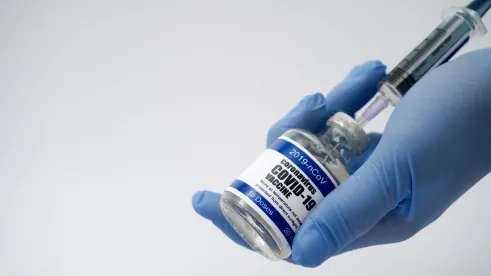At the time of this writing, two companies, Pfizer Inc. and Moderna, Inc., have announced promising early results from Phase 3 of their COVID-19 vaccine trials. Additional promising results are hoped for from Johnson & Johnson, and AstraZeneca soon, and perhaps from others later. This is good news.
Developing a vaccine is one thing, however. Distributing it is another. Indeed, managing the COVID-19 supply chain will pose tremendous logistical challenges for health care providers and at all levels of government unequalled for any other pharmaceutical product in history – and the stakes could not be higher. A complicating factor is, undoubtedly, the turnover of presidential administrations. And while a carefully coordinated handoff from the Trump Administration to the Biden Administration would no doubt be ideal, that may not be forthcoming. However, this turnover also provides an opportunity to reconsider and optimize the role the federal government could play in distributing COVID-19 vaccines to the U.S. population.
Recently, we wrote an article in Law360, describing “Key Government Tools for Addressing National PPE (Personal Protective Equipment) Shortages.” Many of the observations in this article concerning how the federal government can normalize and optimize the supply of PPE to health care providers hold true for COVID-19 vaccine distribution as well – as we shall discuss here.
The Problem
One distribution challenge associated with the COVID-19 vaccines currently in Phase 3 trials is that each of the leading vaccine candidates requires cold-chain transportation and storage, often the case for vaccines. The Pfizer COVID-19 vaccine is unique in that it requires extreme cold (-70 degrees C) storage and, even so, is projected to be viable for only 10 days after manufacture. Accordingly, Pfizer has developed transportation boxes that will accommodate 1000 or 5000-dose shipments, packed in dry ice, and has signaled that it will forego the U.S. government-tapped McKesson Corporation for distribution, in favor of relying on its own systems instead. These requirements for constant deep freezing, immediate use, and packaging into 1000 or 5000-dose containers likely means that the Pfizer vaccine’s use will be limited to large urban centers that can be reached quickly, stored properly, and have sufficient population to justify the batch size. (Similarly, the Ebola vaccine also required extreme cold storage, which posed distribution challenges in many of the places in Africa where it was most needed.)
Moderna and the other three Phase 3 vaccine companies also have indicated that their COVID-19 vaccines will require cold storage and transportation, but only to the level of ordinary cold supply chain capabilities – approximately -20 degrees C. This certainly makes their supply chains somewhat easier to manage, but challenges still remain. Some sources report that vaccines will be constantly temperature-monitored during transit (rather than at intervals), to protect and ensure vaccine integrity.
Another large COVID-19 vaccine distribution challenge is coordinating the logistics of the supply chain, which will have to distribute COVID-19 vaccines to every person in the country. While the federal government has instituted its “Operation Warp Speed” (OWS) – an intragovernmental agency collaboration between the U.S. Department of Health and Human Services (HHS) including the Center for Disease Control (CDC), the National Institutes of Health (NIH), the Biomedical Advanced Research and Development Agency (BARDA), and the Department of Defense (DoD) – so far, the OWS has been short on specifics for how this will be accomplished.
Evidently modelled on the federal government’s plan for the 2009 distribution of the H1N1 vaccine (a challenge of considerable, but still less, complexity), OWS has charged itself with funding the rapid development and manufacture of viable COVID-19 vaccine candidates and relaxing associated regulatory requirements. However, OWS does not include a robust distribution plan to get COVID-19 vaccines to citizens. Rather, like the H1N1 vaccine distribution plan, OWS plans to simply purchase the required vaccines, allocate them to the states using population-based modelling, and then allow the states to distribute the vaccines to their populations – without regard to whether the states have the funding or capabilities to actually do this. And in most cases, they don’t.
In late September 2020, OWS directed the states to submit their COVID-19 vaccine distribution plans by October 29, 2020, which most of the states have done. However, most of the states’ plans at this point are aspirational and non-specific (Ohio’s can be found here) – which is not surprising, considering that the states did not even know in late October 2020 what the cold-chain requirements for vaccine distribution would be. Virginia’s plan specifically called out a “Preparedness Gap,” describing the logistical and financial challenges facing it on this project. On October 15, 2020 – 10 days before the states’ plans were due – the National Governor’s Association sent a letter to President Trump, imploring the administration to provide “additional guidance and clarification … on the roles and expectations of states in a successful COVID-19 vaccine distribution and implementation plan,”– and specifically requesting “a meeting with you and your team to discuss what is required to ensure a strong partnership” with the federal government.
In response, the White House provided few specifics, and referred the governors to OWS’s September 9, 2020 “COVID-19 Vaccination Program Interim Playbook for Jurisdiction Operations” (which was updated on October 29, 2020). The Interim Playbook, however, even in its updated form, sets forth a series of what can be characterized as generalized statements of principle on subjects such as identifying critical populations, vaccine provider enrollment, and handling surplus doses. However, it does not provide the nuts-and-bolts guidance that the states will no doubt need to distribute vaccines effectively. (For example, the Interim Playbook recommends tabletop exercises and workshops to test distribution plans, but does not attempt to describe what such exercises would consist of.)
To be clear, delegation to the states follows the same model that was used with the H1N1 vaccine (which itself was adapted, albeit imperfectly, on the CDC’s Vaccines for Children Program), but H1N1 vaccine distribution involved less urgency (given its relatively low human-to-human transmission rate) and complexity. Nor did the H1N1 vaccine involve an extreme-cold supply chain. And, indeed, following the H1N1 vaccine distribution, the federal government attempted a comprehensive look-back to identify areas of improvement for the time a pandemic required wholesale distribution of vaccines. But if OWS attempts to build on those lessons, the effort is not immediately obvious. Nor is it obvious how the states will fund these vaccine distribution efforts. Although the CDC has estimated that Congress will need to provide up to $6 billion to state and local authorities for vaccine distribution, to date, they have only allocated $200 million.
The Solutions
No matter how managed, distribution of one or more cold-chain COVID-19 vaccines to the U.S. population will pose unprecedented supply chain challenges. However, it is likely inefficient – and probably ineffective as well – to require each of the states to design and implement separate vaccine distribution models and plans. The federal government, on the other hand, has a number of tools at its disposal that can be used to smooth the vaccine supply chain.
First, the Defense Production Act (DPA) can be used to facilitate the distribution of vaccines, as we wrote that it could facilitate the distribution of PPE. The Trump Administration has been parsimonious in its use of the DPA in responsive to COVID-19, asserting that the DPA should be invoked as a measure of last resort. In reality, however, the DPA has been used to distribute millions of federal dollars every year since its creation in 1950, when needed by America.
Under the DPA, the federal government can marshal the resources necessary to actively coordinate the distribution of COVID-19 vaccines, including by requisitioning logistics providers and supply chain experts to assist in the effort to create a more centralized procurement and distribution process. Importantly, if there are air transport shortages that impede vaccine distribution, the DPA authorizes the President to activate the Civil Reserve Air Fleet.
Second, part of what makes COVID-19 vaccine distribution so challenging are the unknowns. While the states are scrambling to put together sensible distribution plans that adequately cover the entire U.S. population – and while the H1N1 vaccine distribution provides some guidance – the federal government is best poised to handle the information-gathering component of vaccine distribution. This will be particularly helpful for distribution areas that cross state lines, for which intra-state distribution models are inefficient and impractical. The federal government is also best poised to track feedback data nationwide – which will enable it to adjust distribution plans and quantities as consumption patterns emerge.
Third, the Strategic National Stockpile, which received its first real test under President George W. Bush following September 11, 2001, has played a role in addressing previous crises, including the H1N1 pandemic in 2009. The knock on the Strategic National Stockpile has been that its planning capabilities have always exceeded its response achievements – but that means that this is its chance to shine. And the Strategic National Stockpile’s greatest strength may be in its ability to act as a supplemental resource, smoothing out uneven or suboptimal resource distributions between markets and states. A disciplined Strategic National Stockpile response, coupled with rigorous vaccine distribution information gathering, would take significant resource strain off state and local governments and health care institutions.
Conclusion
The change in administrations provides an opportunity to re-evaluate the role of the federal government in distributing COVID-19 vaccines. We should make use of this opportunity to address this national crisis.




 />i
/>i

